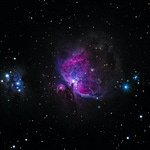In this podcast episode, I talk about a recent encounter I had with a deer that I considered a good omen for a mantra practice I’ve recently started.
The universe often speaks to us, we just have to learn to slow down, tune in and listen.
This is where omens come in.
What’s an omen?
In Jyotish (Vedic astrology), for something to be considered at omen, it needs to be:
an unusual occurrence
For example, with the story about the deer, I’ve sat at that same bench many times in the past ten years. Never once have I seen a deer in that meadow, let alone had one approach me out of the blue. If deer sightings and encounters were more common in the area, this experience would have seemed less like an omen I should pay attention to.
happen shortly after a question or statement has been made or an action has been concluded
Let’s consider a more mundane example. Say you apply for a new job. You get your application ready, upload your documents and press send. Of course, now you’re wondering, “Will I get the job?”
A few minutes later you check your messages and see you’ve gotten a text from a friend with wonderful news (“We’re pregnant!” or “We got the house!”) or one with bad news (“I owe more in taxes than I thought.” or “My mom is ill.”)
Although this message isn’t directly related to your job application, the fact that it came through shortly after you completed this action could be considered a positive or negative omen about the final result.
However, this would not be the case if the text came before you sent the application or many hours afterward.
Don’t ignore, but also don’t overinterpret
It’s important to remain open and receptive to omens; however, you should avoid actively seeking them out at all times. The universe does give us answers at times, yes, but in my experience that does not mean she’s a Chatty Cathy.
That’s what makes omens special: they are only delivered when something really needs to be said.
Let’s move on now to Nimitta.
Omenology: One of the Six Branches of Jyotish
Nimitta (omen/sign), or Shakun Shastra, is a very interesting branch of Vedic astrology that concentrates specifically on interpreting omens to gain deeper understanding or make future predictions.
Types of Nimitta include:
Natural Phenomena: This includes unusual weather patterns, celestial events, or natural disasters.
Animal Behavior: The actions and behavior of animals, birds, and insects can be interpreted as omens.
Physical Sensations: Unexplained bodily sensations or experiences can also be considered Nimitta.
Dreams: Specific types of dreams and their symbols are interpreted as predictive signs.
One of the most significant classical Jyotish texts with chapters specifically on Nimitta is The Brihat Samhita, written by the 6th century astrologer and polymath, Varahamihira. This book include omens connected with specific animals, such as birds, cows, dogs, elephants, and so on.
Reinterpreting ancient omens
Obviously, the world has changed quite a bit since the 6th century. However, that does not mean the omens listed in Brihat Samhita don’t have merit – they just may need to be modernized in some cases.
For example, elephants are obviously a bit hard to come where I live in Europe. However, if we consider what an elephant would be used for in the ancient world – namely, work and transportation – could we perhaps update the omen as being signified by a bus (i.e., large mode of transportation) or a crane (i.e., large machine for work and hauling)?
Or could we translate the omen of a crow landing on a dead tree as one landing on a city telephone pole?
Definitely omenology food for thought worth testing.
Omens never stand alone
In Chapter 96: Supplementary to Omens XI, Varahamirhira writes:
A person learned in the sciences of omens shall make predictions taking into account the dik (direction), place, motion, sound, week day, the Nakshatra, the Muhurta, the rising sign, the Karana (half a lunar day), the rising Navamsa and the fixed, moveable or double nature of (astrological) signs (of the planets) and their strengths and weaknesses.
In other words, omens are simply an additional layer an astrologer adds to bring depth and accuracy to their interpretations and predictions, one that is always paired with other techniques and important considerations.
Michelle R. Dean is a Vedic astrologer and writer based in Berlin. To find out more about Michelle or book a Vedic astrology consultation, swing by here.















Share this post